
About Andrew Cusack
 Writer, web designer, etc.; born in New York; educated in Argentina, Scotland, and South Africa; now based in London.
Writer, web designer, etc.; born in New York; educated in Argentina, Scotland, and South Africa; now based in London. read more
News
Blogs
Reviews & Periodicals
Arts & Design
World
France
Mitteleuropa
Knickerbockers
Argentina
The Levant
Africa
Cape of Good Hope
Netherlands
Scandinavia
Québec
India
Muscovy
Germany
Academica
Governors Island
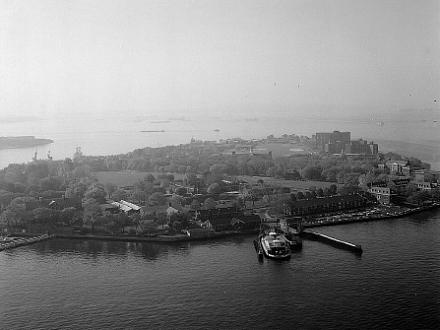
GOVERNORS ISLAND IS one of New York’s hidden gems. Not only is it a place which has a long and storied history, but it remains, however underappreciated, a place of great beauty, not to mention a place of great potential. The fact that this island in New York Harbor has been the property of the government for the preponderance of its existence has shielded it from the destructive forces of commerce which have savaged so much of what is beautiful and historic in the remainder of the city.
Let us explore this intriguing isle…
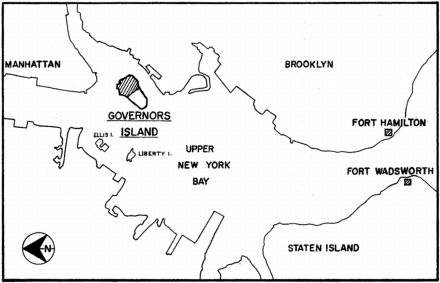
Governors Island sits in Upper New York Bay at the mouth of the East River (which is not actually a river, but instead a tidal strait) between Manhattan and Brooklyn. This island of 172 acres is separated from Brooklyn by the Buttermilk Channel, which centuries ago disappeared at low tide, allowing Brooklyn farmers to cross and let their cows graze on the island. It has since been dredged numerous times to ease its function as a shipping lane.
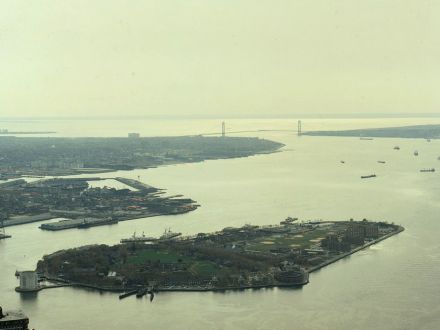
Originally called Nutten Island (Noten Eylandt) by the Dutch, it was where the first founders of New Amsterdam disembarked, and thus has been declared by a joint resolution of the Senate and Assembly of the state as the birthplace of New York. After the English took New Amsterdam, it was renamed Governors Island (plural, not possesive) since the Provincial Assembly of New York dedicated it to the perpetual and exclusive use of the colony’s royal governors. The island was originally only less than half the size it is today, the natural island being indicated more or less by the shading in the map above. Later landfills (possibly using unused ordinance) expanded the island to the south, more than doubling its size.
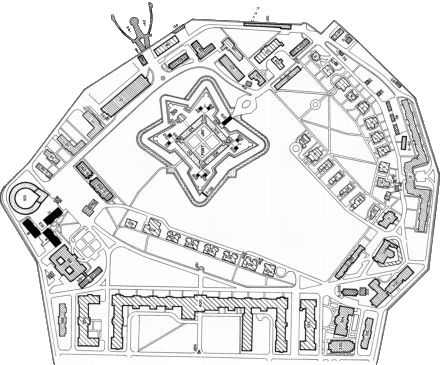
This northern portion of the island (above) is really the only historic part. It contains Castle Williams, where according to legend Walt Disney was once imprisoned, Fort Jay, the 1806 fortification named after John Jay, the first Chief Justice of the U.S. Supreme Court and sometime Governor of New York, a series of Victorian and earlier officers’ homes, as well as Liggett Hall, the longest building in the world when it was constructed. St. Cornelius Chapel is still owned by Trinity Church, and thus the only part of the island not owned by the government. Oh, and a nine-hole golf course.

From 1783 when King George granted independence to New York and twelve other North American colonies, the British soldiers evacuated the city and the United States Army took possession of Governors Island. The Army stayed for one hundred and eighty three years before handing control of the island over to the United States Coast Guard, which operated on the island until 1997. In 2003, the U.S. government returned most of the island to the State of New York except for 22 acres surrounding Castle Williams and Fort Jay to be maintained by the National Park Service as Governors Island National Monument. The entire historic portion of the island was declared an historic district by the U.S. government and by the City of New York. [See map below]
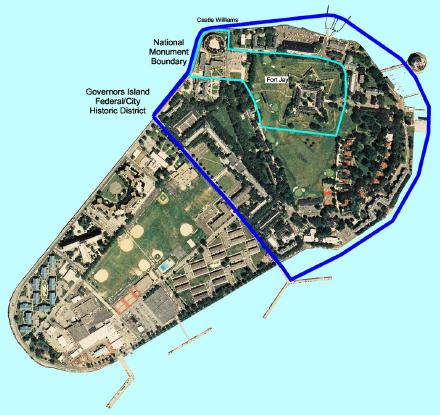
From the 1900’s, with the growing popularity of polo, the open southern (landfill) part of the island was used for polo grounds and became the home of the U.S. military’s polo teams; indeed George Patton himself played polo on Governors Island. Military teams often dominated competitive polo and to this day American interscholastic polo is still dominated by the ever-decreasing number of military schools (Culver and Valley Forge mainly, I am told).
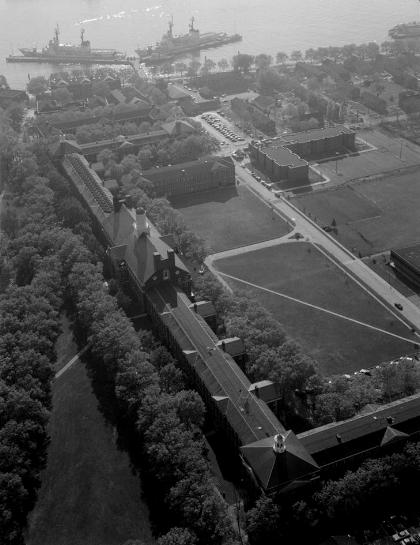
In 1929, the Army feared the City of New York was eyeing the convenient location of Governors Island as a site for a new municipal airport. In response, Liggett Hall (above) was designed by McKim, Mead, and Wright and built practically across the width of the island. It was believed to be the longest building in the world when it was completed, and was the first Army structure to house all the facilities for an entire regiment.
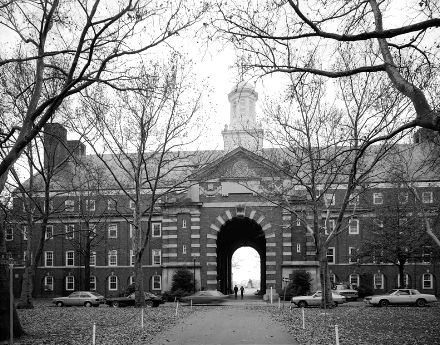
A view of Liggett Hall from the north.
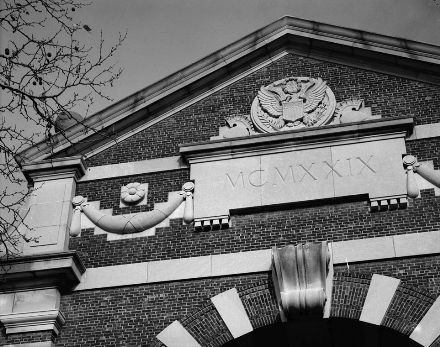
Detail of 1929 in Roman numerals on Liggett Hall.
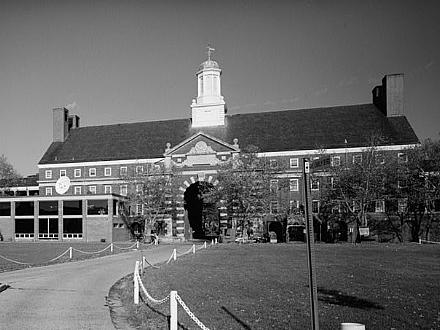
Liggett Hall viewed from the south, including an ugly modern structure built as an afterthought.
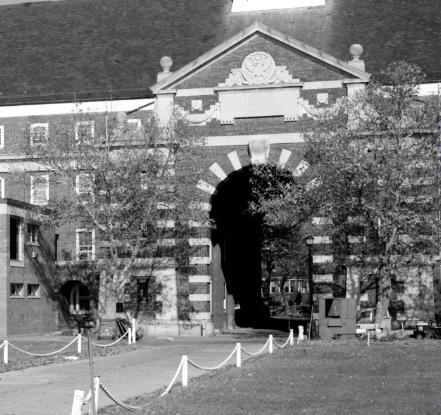
The great arch of the building.
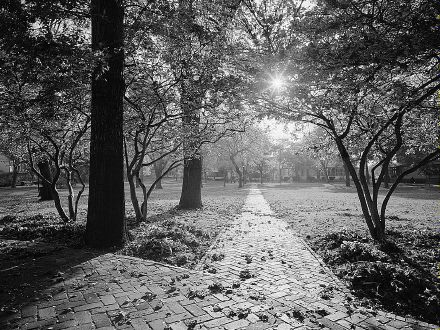
Nolan Park (above) has the look of a New England village green, while much of the island (below) exudes the feeling of a college campus.
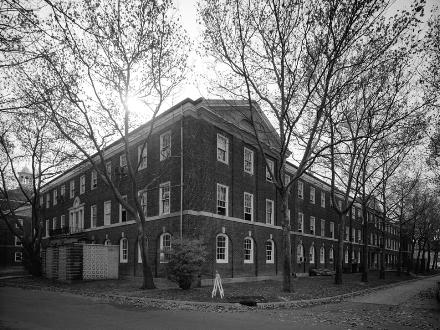
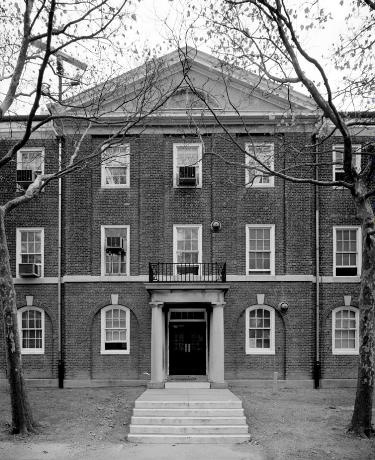
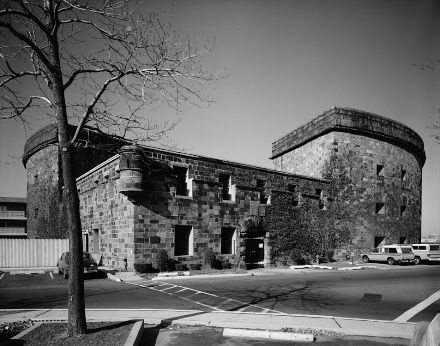
Castle Williams (above and below) is a fortification on the northern point of the island. When its use as an artillery battery was outdated, it became the post stockade. Walt Disney was alledgedly held here overnight after being found (accidentally, it is claimed) absent without leave. There is currently a project (previously reported upon) to turn Castle Williams into a New Globe Theatre ‘as a world-class performing arts center to educate and entertain the public with affordable, accessible and stimulating programming’.
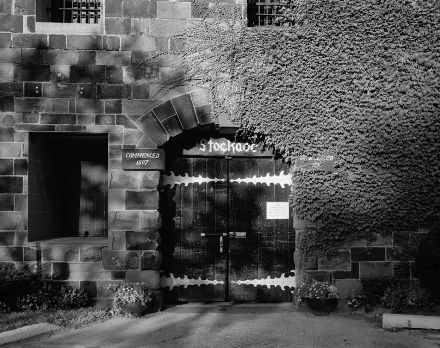
The Castle’s entrance
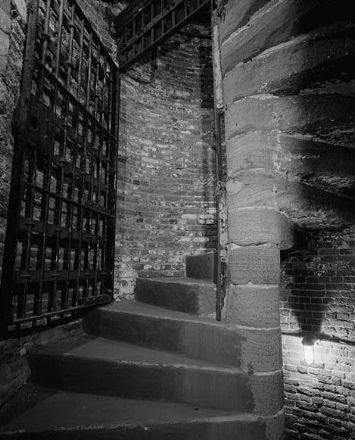
A twisting stone stairway in Castle Williams.
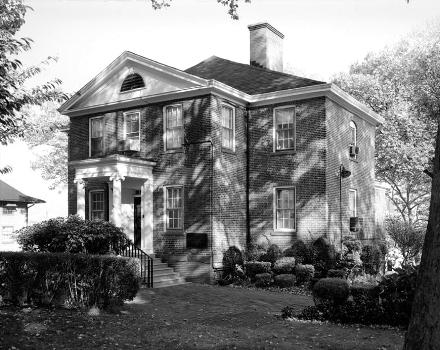
Tradition holds that the Governor’s House (above) was built in the early 1700’s and used by a series of New York’s royal governors. Pedantic historians, however, have attempted to debunk these claims and hold that it was only constructed some few years before the War of 1812. The Governor’s House was home to the commanding officer of Governors Island until the construction of the Admiral’s House.
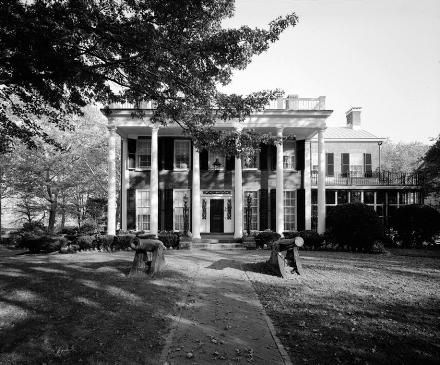
Since its construction in 1843, the Admiral’s House (above) has served as the home for the ranking officer on Governors Island. From 1843 to 1878 this was the post commander, from 1878 to 1939 the commander of the army command on the island, from 1939 to 1966 the Commander of the First Army, and afterwards until 1996 the Third Coast Guard District commander (Governors Island was the largest USCG station until its close). It was also the site of a summit between Ronald Reagan and Mikhail Gorbachev in the 1980’s.
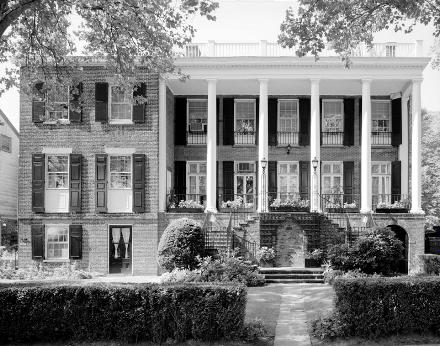
The rear façade of the Admiral’s House.
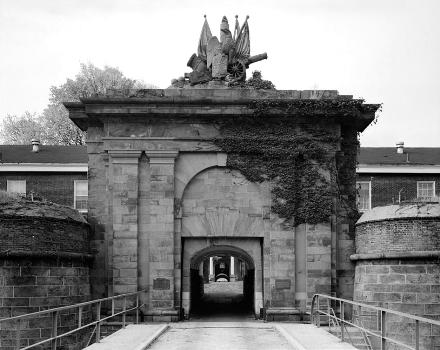
The walls and gate (above) of Fort Jay were built in 1806 and remain to this day. Above the sandstone gate is a sculpture representing the instruments of war, flags, a fasces topped with a Phrygian cap, and an eagle supporting a shield displaying the arms of the State of New York (as also seen atop this website).
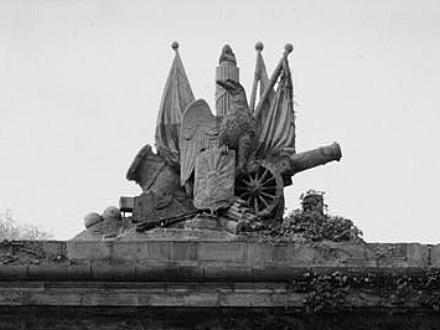
The sculpture atop the gate of Fort Jay.
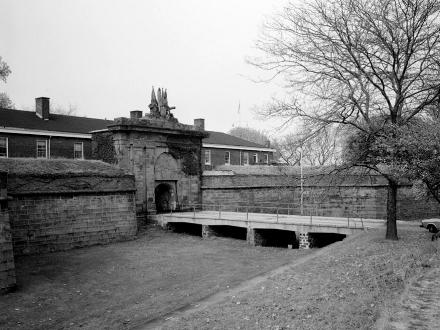
A view of the gate of Fort Jay from the barbican.
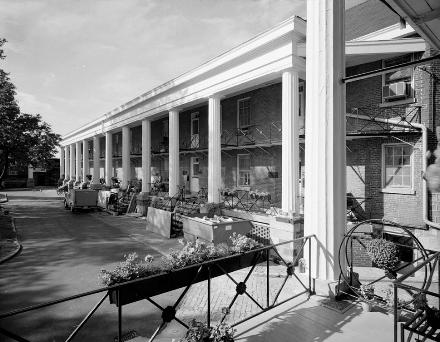
Nineteenth-century structures within the interior of the fortifications.
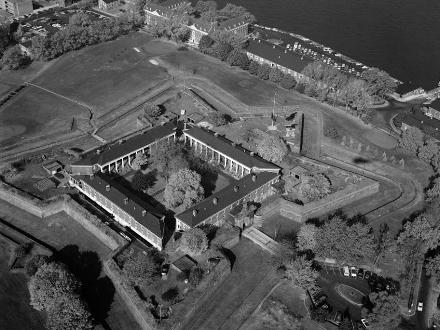
An aerial view of Fort Jay.
With most of the island in the hands of the State, there is a great debate as to what to do with it. A number of official proposals have been made by the Governors Island Preservation and Education Corporation, a public body chartered by the State of New York to manage the island. These proposals include:
• ‘Destination Island’ – Creating a major tourist destination on the island with conference center, theme hotel, and retail.
• ‘Iconic Island’ – Commissioning celebrity architects to create conference center, signature amphiteatre, recreation facilities.
• ‘Innovation Island’ – Creating a technology research campus with sports and recreation facilities.
• ‘Minimum Build Island’ – Taking down the ugly modern structures and returning the southern portion of the island to greenery.
Of these distinctly uninspired proposals, ‘Minimum Build Island’ (plan below) is the least offensive. In all of the proposals, the general plan for Liggett Hall and the northern part of the island remains the same, which is to use it primarily for unspecified educational purposes.
I think it would be great to put a military college on the island. If Virginia and South Carolina can have excellent state military colleges then why not the Empire State? A military college would have the potential of cultivating an elite in the public interest focused on excellence rather than egalitarianism and would also continue the military tradition of the island. And I’d bring back polo and leave as much of the southern half of the island as open and green as possible. It’ll never happen.
Still, once can imagine the State doing something terrible to mess up the island like putting some ugly new ‘signature’ buildings designed by the latest star-chitects (Foster, Liebeskind, Gehry, and the rest of the talentless hack school of architecture), so in many ways the less the State does, the better. All that really needs to be done is to maintain the buildings so that some future generation with more sense can come along and make something good and decent of Governors Island.

Most images from the Library of Congress.
Search
Instagram: @andcusack
Click here for my Instagram photos.Most Recent Posts
- Gellner’s Prague December 19, 2024
- Monsieur Bayrou December 18, 2024
- Dempsey Heiner, Art Critic December 17, 2024
- Vote AR December 16, 2024
- Articles of Note: 12 December 2024 December 12, 2024
Most Recent Comments
Book Wishlist
Monthly Archives
Categories



Really enjoyed your Ft Jay/Governors Island writeup. As a draftee, I was stationed there in the early 60s. Was a great time in my life in the “peacetime” army, although it was a time of ferment with Civil Rights marches. Exciting times. Met my future wife while in the city. So many adventures. Would like to turn the clock back and do it all again. Alas!
Nice stuff!
>>>>Still, once can imagine the State doing something terrible to mess up the island like putting some ugly new ‘signature’ buildings designed by the latest star-chitects (Foster, Liebeskind, Gehry, and the rest of the talentless hack school of architecture)< HAHAHAHA Good one Andrew... http://www.forgotten-ny.com
Thanks for the Gov.Is. tidbits. I was in a cermonial platoon there in 1958 and cherish those memories of “good duty” in a special place. I was transferred to Ft.Jay from the 4th RCT in Ft. Devens, Mass. in 1958. I arrived at that station in April, assigned to a small detachment that performed ceremonial duties in Manhattan, some parts of upstate, and parts of New Jersey. Ours was a close knit group of enlisted men, mostly draftees, reassigned from infantry companies. We were part of HQ & HQ Company, 1st Army. Typically there were 15 to 20 of us and our duties were solely to present the colors at ceremonies and parades and to conduct many, many military funerals. The funeral directors in that area were keenly aware that military veterans were entitled to a “free” burial with honors. Although the formal funeral detail was usually comprised of seven riflemen firing 3 volleys (21 gun salute), ours was always 3 riflemen, an NCOIC and a bugler. We were very professional and efficient, sometimes one detail doing as many as 3 per day. Here’s the best part…….we had not one NCO or officer in the group. A very together Spec3 named Bob Anson ran the show and assigned the details. Never a glitch. And thennnn………………there arrived a Sgt. 1st. class (SFC) who was going to “change things for the better”.
Sometime around midsummer that year we were told that an Argentine training ship was coming to port and we were to answer her 21 gun salute. Our proud new SFC acquired three 105mm howitzers and then set into motion a very complicated drill for firing those guns 7 times each for the magic 21. We practiced on the grassy airfield facing the Statue of Liberty. Stopwatch in-hand, the good sergeant ran us through his precisely timed drill, over an over. Unfortunately we never fired one shot, not wanting to “spend” the precious blank rounds. Well, the day of the ships arrival dawned and we lined up facing the Narrows, 3 men to a gun, blank shells stacked alongside. Wow! The Argentinians sailed by, guns blazing 21 times, an impressive sight. Then it was our turn, “Number one, FIRE!”, the Sgt yelled proudly, bang; “number 2 FIRE!” clank; “number 3 FIRE!”, clank. And so it went, misfires and bangs in an eclectic mix of carefully timed chaos. Everytime there was a misfire the gunners would eject the shell casing and reload. There was such a melange of misfires, the Sgt. and his still-running stopwatch lost count of how many shots really rang out. For sure it wasn’t 21. A few of us thought we saw Lady Liberty smirk. We heard the next day that the abortive salute was a serious breach of military protocol and the Argentine Embassy was sent a formal apology. We smirked. The good sergeant’s days were numbered and he was quickly sent elsewhere…..to the great delight and relief of all who remained on glorious Governor’s Island. Good duty!
Dave Schmitt
I was on the decommisioning team that turned Ft, Jay over to US Coast Guard Base New york on June 30. 1966. I was a 1st Lt Quartermaster Corp and the last of the Officers to leave the Island
I lived on Governors Island from 1929 to 1936. I was born at Ft. Totten Station Hospital, the daughter of an Army Sgt. who was stationed on Governors Island. I have many childhood memories of my time there and would love to revisit the island for old times sake. How can this be arranged? I have quite a few pictures, too, taken while living there which helps to bring back the old memories. I remember being moved from wooden two story barracks overlooking the parade grounds to modern brick barracks in about 1934 — a big improvement. Living on the Island has been sorta my “claim to fame” as it was an unusual children and a memorable one. Peggy Burch Saliunas
I can’t find the other Fort Jay/Governors Island web site. So I’ll post here in this friendly site. Actually Andrew your site has the best photos of all. And your web site has other great postings. So I feel at home here. So here goes.
Again Andrew, you have done a remarkable job on this site. So here goes with some longish remembrance of my duty at Fort Jay. As a draftee I had “chance not choice” for military duty. So the Army trained me at Fort Sam Houston down in San Antonio Texas to be a dental assistant. I recall getting my orders for my duty station at an esoteric “Fort Jay.” And a fellow soldier from New Jersey told me I had “hit the jackpot” because I mentioned I hoped the Army would send me to New York. So yes, dreams do come true! :)
I recall trying to find the right subway to get to Governors Island and while maintaining a casual air about me as if I were a New Yorker. But that rouse was hard to maintain because I had a huge duffel bag to schlep around. So I left the heavy bag in what I figured was a dark corner of Grand Central Station and walk about. What a fool I was. I came back and the bag was gone! Then an MP stopped me and summoned me to follow him to an office. I was told to look in a room in back of the office. There was my duffel bag!
I was told to take the “1 train” to South Ferry and take the ferry to the island. And then I checked into LIggett Hall. Having checked into the medic barracks section, which was between the MP section and the long building’s admin section, I had the weekend to myself, thanks to having in-processed on a Friday. So then began my first my New York adventure, where I got lost!
More later. Stay tuned! :)
When Governor’s Island was still in Military hands, I got to visit the place, courtesy of a member of the Coast Guard who was in St. Patrick’s choir with me. It was a wonderful place, almost a time warp. I remember the houses and streets there feeling like a trip back to the America of old movies. I think they should change nothing on this island, no new buildings. A military school would be perfect there, and why not polo?
I was stationed at Governors Island from November 1967 to May 1968 right out of boot camp attending Electronics Technician School. It seemed like a hotel compared to being a boot. I loved the view of lower Manhattan. Usually a bunch of us would have liberty every weekend and we would explore NYC. Unfortunately the pay for an E2 was only 43 dollars every 2 weeks which didn’t go far even back then. I remember poker game every payday evening. I didn’t play poker and still don’t. There must have been a lot of bad poker players because a few guys wound up with most of the money.
On TDY from Fort Dix, I spent the autumn of 1962 on Governors Island, my best three months in the army. I was a Spec. 4 and a surveyor in HQ Co. of the 86th Engineer Battalion. Our detachment included personnel from the line companies, who repaired roads and worked on other maintenance projects. I remember one project in particular. Behind Ligget Hall, we put in a sidewalk across the parade ground to the base cafeteria. Instead of the usual routine of looking through the transit, my sergeant ordered me to help with the manual labor. By the end of the day my hands had blisters.
I often drove a duce and a half truck loaded with a work crew to one of their projects. One morning, I stopped at the entrance of the old fort. The corporal sitting next to me jumped out and assured me the truck could safely pass under the arch. I slowly drove forward then heard a cracking noise and the yelling of soldiers in the back. The canvas and the wooded supports were ripped off. I later took the truck to the deserted motor pool, and the corporal exchanged canopies from another truck.
While working on the western perimeter of the island, you could look across the harbor and see the Statue of Liberty. One day, the Queen Mary came into port, and she was visible towering over the buildings of the base.
I made friends with a few of the lucky ones stationed on the island. Our group included a MP inside the stockade, three Wacs from personnel besides the organists for the Catholic and Episcopal churches. We often met at night in the basement kitchen of the Episcopal Church. Drinking coffee and sometimes wine, we played word games and usually complained about the army.
Always short of money, we went to the USO near Times Square and pickup free tickets to Broadway plays. We were told to wear civilian clothes. I assumed the theatres liked to appear sold out and not obviously giving free tickets to a row of soldiers.
The Cuban Missile Crisis in October nearly cut short our time on Governors Island. We were given shots at the base hospital and signed next-of-kin papers. Our battalion at Fort Dix was on alert. For a week, we expected the order to leave then the crisis ended. In early December, I drove a truck without a heater, following the convoy out of New York City.
I recall my wondrous draftee days at Fort Jay in 1961 and 1962. Wish I could go back in time and remain there.